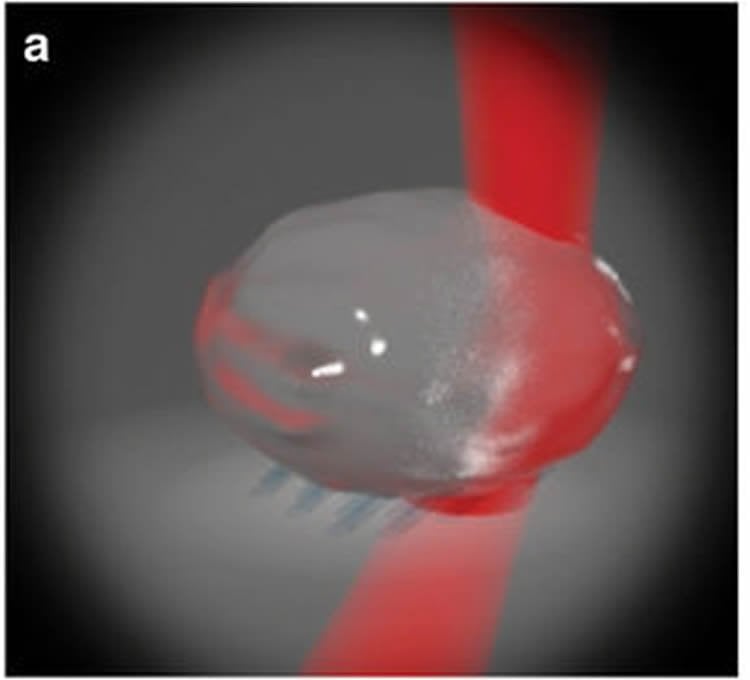Summary: Researchers have developed a new way to help understand how the vestibular system works as an animal stands still. The method involves using optical tweezers to study the activity in the vestibular system.
Source: University of Queensland.
Finding out what’s happening in the brains of people with balance disorders, such as vertigo, might be one step closer following new research on the vestibular system, which controls balance and movement.
An interdisciplinary University of Queensland team of optical physicists and biologists has found a novel way, using optical tweezers, or focused beams of light, to understand the vestibular system while animals are still, not moving.
School of Biomedical Sciences’ Associate Professor Ethan Scott said the vestibular system, which detects gravity and motion, was crucial to survival, but the nerve circuits processing vestibular information were not completely understood.
School of Mathematics and Physics’ Professor Halina Rubinsztein-Dunlop said this new research was significant because it demonstrated that optical trapping was sufficiently powerful and precise to move large objects, it and set the stage for functional mapping of vestibular processing.
“It opens the door to using other techniques that can help us understand the neural circuits in the brain that mediate vestibular perception and may also ultimately benefit people with vestibular disorders such as dizziness, vertigo and imbalance”, said Associate Professor Scott.
“The vestibular system, found in the inner ear in most mammals, had always been hard to study, because it was active in response to movement.”
“Movement makes it difficult to record using neurons in the brain, and this has complicated past studies of the vestibular system,” he said.
“We needed a way to activate the vestibular system without the animal moving.”
The solution came in the form of optical physics and a technique called optical trapping, or using highly focused laser beams to physically hold and move microscopic objects, similar to tweezers.
“By focusing a laser at the edge of an object, we can apply physical forces to it,” said Professor Halina Rubinsztein-Dunlop of the School of Mathematics and Physics at UQ.
Dr Itia Favre-Bulle, a postgraduate at the time of the study and now a postdoc on the continuation of the project, working with the Scott and Rubinsztein-Dunlop teams, brought this theory to practice using zebrafish as a model.

Dr Favre-Bulle targeted an infrared laser toward the otoliths, or ear stones, of larval zebrafish, thus placing forces on them similar to the forces that would result from actual movement.
This resulted in behavioural responses like those that zebrafish larvae display when undergoing real-world vestibular stimuli, like acceleration or rolling, even though the animals were still.
“From a technical standpoint, this is exciting because these are the largest and most optically complex objects that have been manipulated with optical trapping, and the technique was effective even though the targets were deep within a living animal,” Dr Favre-Bulle said.
Source: Halina Rubinsztein-Dunlop – University of Queensland
Image Source: NeuroscienceNews.com image is credited to Scott el al./Nature Communications.
Original Research: Full open access research for “Optical trapping of otoliths drives vestibular behaviours in larval zebrafish” by Itia A. Favre-Bulle, Alexander B. Stilgoe, Halina Rubinsztein-Dunlop & Ethan K. Scott in Nature Communications. Published online September 20 2017 doi:10.1038/s41467-017-00713-2
[cbtabs][cbtab title=”MLA”]University of Queensland “Shining a Light to Understand the Body’s Balance System.” NeuroscienceNews. NeuroscienceNews, 7 October 2017.
<https://neurosciencenews.com/lasers-vestibular-system-7684/>.[/cbtab][cbtab title=”APA”]University of Queensland (2017, October 7). Shining a Light to Understand the Body’s Balance System. NeuroscienceNews. Retrieved October 7, 2017 from https://neurosciencenews.com/lasers-vestibular-system-7684/[/cbtab][cbtab title=”Chicago”]University of Queensland “Shining a Light to Understand the Body’s Balance System.” https://neurosciencenews.com/lasers-vestibular-system-7684/ (accessed October 7, 2017).[/cbtab][/cbtabs]
Abstract
Optical trapping of otoliths drives vestibular behaviours in larval zebrafish
The vestibular system, which detects gravity and motion, is crucial to survival, but the neural circuits processing vestibular information remain incompletely characterised. In part, this is because the movement needed to stimulate the vestibular system hampers traditional neuroscientific methods. Optical trapping uses focussed light to apply forces to targeted objects, typically ranging from nanometres to a few microns across. In principle, optical trapping of the otoliths (ear stones) could produce fictive vestibular stimuli in a stationary animal. Here we use optical trapping in vivo to manipulate 55-micron otoliths in larval zebrafish. Medial and lateral forces on the otoliths result in complementary corrective tail movements, and lateral forces on either otolith are sufficient to cause a rolling correction in both eyes. This confirms that optical trapping is sufficiently powerful and precise to move large objects in vivo, and sets the stage for the functional mapping of the resulting vestibular processing.
“Optical trapping of otoliths drives vestibular behaviours in larval zebrafish” by Itia A. Favre-Bulle, Alexander B. Stilgoe, Halina Rubinsztein-Dunlop & Ethan K. Scott in Nature Communications. Published online September 20 2017 doi:10.1038/s41467-017-00713-2







